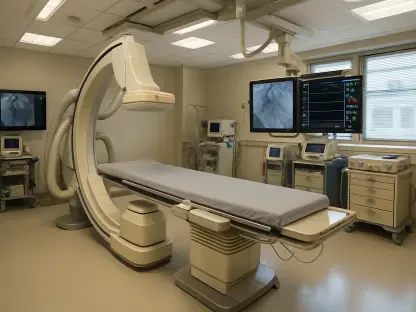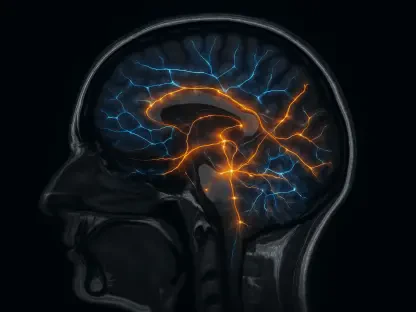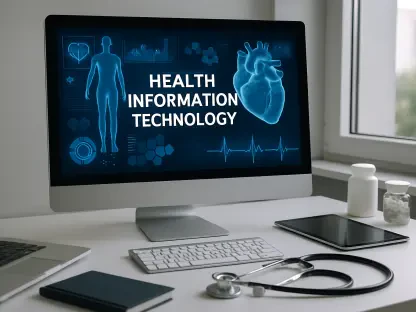The increasing administrative burden on clinicians has become a significant issue in the healthcare industry, leading to burnout and decreased job satisfaction. With the integration of AI-powered documentation solutions, there’s a shift from traditional methods to more efficient, automated systems. This transformation holds the potential to revolutionize clinical care by allowing clinicians to focus more on patient interaction and less on paperwork.
The Challenges of Clinical Documentation
The Weight of Administrative Tasks
Physicians and Advanced Practice Providers (APPs) often find themselves overwhelmed by extensive documentation requirements. The need to meticulously document each patient interaction consumes a significant part of their workday, contributing to stress and professional fatigue. This administrative overload not only detracts from patient care but also negatively impacts clinician well-being and job satisfaction. The volume of paperwork has been particularly challenging, as detailed logs are not merely clinical notes; they involve comprehensive records that include patient histories, treatment plans, and follow-up care. Many healthcare providers have expressed that the focus on constant documentation detracts from their primary mission of providing patient care. When the bulk of a workday is spent on data entry, the opportunity for meaningful patient engagement diminishes considerably. This imbalance can lead to a sense of disillusionment among clinicians, who may feel that their specialized skills are underutilized. The bureaucratic demands compound the challenges of an already high-stress profession, leading to a cycle of fatigue and decreased job satisfaction.
Impact on Clinician Well-being and Patient Care
The effects of heavy documentation workloads extend beyond the clinicians themselves. Patients can experience decreased quality of care as doctors have less time for face-to-face interactions and personalized care. High levels of burnout among clinicians have led to decreased productivity, higher turnover rates, and in some cases, professionals leaving the field entirely. Clinician well-being is intricately tied to the quality of care provided; when clinicians are overburdened, patient outcomes can suffer. Excessive documentation requirements lead to a hurried interaction between the patient and provider, often resulting in less thorough consultations. Burnout has a ripple effect, influencing the entire healthcare ecosystem. When clinicians experience professional fatigue, the likelihood of errors increases, and the patient-clinician relationship can become strained. These conditions create an environment where both patients and providers experience suboptimal outcomes. Addressing this imbalance is crucial, as maintaining a healthy, engaged workforce is essential for delivering high-quality patient care. The emotional and psychological toll of continuous administrative workload cannot be underestimated, highlighting the need for sustainable solutions.
Initial Solutions: The Introduction of Scribes
Scribes: A Temporary Relief
In 2017, Novant Health introduced in-person scribes to assist with the documentation process. This move resulted in notable improvements in job satisfaction and freed up time for clinicians to engage more deeply with their patients and other responsibilities. However, issues such as staffing shortages and the impact of the COVID-19 pandemic highlighted the need for a more sustainable solution. Initially, the introduction of scribes seemed like a promising strategy to alleviate some of the burdens clinicians faced. These assistant roles allowed doctors to focus on patient care while ensuring that documentation was completed accurately and promptly. While the presence of scribes provided much-needed respite from the continual cycle of documentation, it became evident that relying heavily on human support introduced its own set of challenges. Inconsistencies in the quality of work, the need for constant training, and the logistical difficulties of maintaining a consistent pool of scribes became apparent. These limitations underscored the importance of finding a more scalable and robust solution that could consistently deliver high-quality documentation support without the ongoing challenges associated with human factors.
Benefits and Limitations of In-Person Scribes
While scribes offered a temporary respite from documentation burdens, they were not a perfect solution. The reliance on human scribes introduced variability in documentation quality and added logistical challenges related to staffing and training. The need for a more consistent and scalable solution became evident. Scribes were particularly beneficial in the short term, strikingly reducing clinician burnout and allowing doctors to reallocate their focus toward patient-centric activities. However, these benefits were tempered by the reality of operational challenges. Ensuring a continuous and skilled workforce of scribes proved difficult, especially during periods of heightened healthcare demand, such as the COVID-19 pandemic. Furthermore, while scribes did mitigate some of the administrative workloads, they could not completely eliminate it. The ultimate goal was not just to reduce documentation time but to enhance the overall efficiency and effectiveness of clinical operations. Thus, while the introduction of scribes marked an important step towards addressing the administrative burden, it highlighted the need for a more technologically advanced and dependable solution. The limitations experienced provided critical insights that would pave the way for the adoption of AI-powered documentation solutions.
Transition to AI-Powered Transcription Solutions
Early Attempts and Challenges
The shift to AI-based documentation solutions began in earnest in 2020, with mixed results. Initial versions of AI transcription tools, which included human review, often produced inconsistent documentation quality. Clinicians faced a learning curve as they adapted to these new technologies, and their feedback was crucial in refining the tools. The integration of AI into clinical documentation heralded a new era, but the initial phases were fraught with challenges. Early AI-powered solutions, reliant on a combination of automated systems and human oversight, sometimes failed to meet the high standards required in medical documentation. These early attempts underscored the complexity of clinical language and the nuanced understanding needed to produce accurate and meaningful records. Despite these setbacks, the iterative process of refinement continued, driven by exhaustive feedback from end-users. Clinicians’ practical insights were instrumental in evolving the technology, identifying gaps, and optimizing functionality. These early challenges served as a learning curve, setting the stage for more refined and fully automated systems that would eventually offer robust solutions to the documentation dilemma.
The Rise of Fully Automated AI Solutions
In 2022, Novant Health introduced a fully automated AI transcription solution that proved to be a game-changer. The new system not only improved note turnaround time but also significantly reduced the cognitive load on clinicians. By automating the transcription process, clinicians were able to devote more time to patient care and experienced improved work-life balance. The fully automated AI solutions emerged from the lessons learned in earlier implementation phases, offering a more streamlined and error-resistant approach to clinical documentation. These advanced systems could accurately transcribe patient interactions in real-time, diminishing the need for extensive human review. Clinicians expressed relief as the cognitive burden of extensive documentation was dramatically reduced. The execution of administrative tasks became almost seamless, allowing providers to regain focus on patient care. This marked improvement in operational efficiency contributed positively to clinician job satisfaction and overall well-being. The implementation of these AI solutions demonstrated that technology could effectively support high-stress professions, transforming workflows and significantly enhancing productivity. The initial skepticism surrounding AI integration began to dissipate as the tangible benefits became apparent, positioning AI as a pivotal component in modern healthcare documentation.
Benefits of AI-Powered Documentation
Reducing Cognitive Burden and Burnout
One of the most significant advantages of AI transcription is its ability to reduce the cognitive burden on clinicians. By handling repetitive and time-consuming documentation tasks, AI systems enable clinicians to conserve their mental energy for patient care. This reduction in workload has led to a noticeable decrease in burnout rates among healthcare professionals. The cognitive load associated with medical documentation can be overwhelming, disproportionately affecting the quality of care a clinician can provide. By automating these tasks, AI transcription solutions liberate clinicians from the minutiae of paperwork, allowing for a more focused and effective approach to patient care. Reduced cognitive load translates to a more sustainable work environment, where clinicians can maintain their levels of enthusiasm and commitment. This not only enhances individual job satisfaction but also promotes a healthier work-life balance, an essential factor in mitigating overall burnout. The widespread adoption of AI transcription solutions thus holds profound implications, offering a viable path to counteracting the pervasive issue of clinician burnout that plagues healthcare systems globally. The clear positive impact on mental well-being emphasizes the critical role of technology in reshaping the future of clinical practice.
Enhancing Job Satisfaction
With the burden of documentation lifted, many clinicians have reported increased job satisfaction. The freedom to focus on patient interactions and clinical decision-making has rekindled their passion for medicine. Positive feedback from users highlights the transformative impact of AI on their daily workflows and overall professional experiences. The alleviation of documentation responsibilities has not only improved the efficiency of clinical operations but has also renewed clinicians’ sense of purpose. Engaging more fully in patient care, without the distraction of extensive record-keeping, enables doctors to experience a more fulfilling professional life. This reclamation of time and mental resources fosters an environment where clinicians can thrive, rediscovering the intrinsic rewards of their chosen profession. Testimonials from healthcare providers frequently underscore the profound sense of relief and rejuvenation brought about by AI documentation tools. This renewed job satisfaction resonates throughout healthcare teams, promoting a collaborative and engaged workforce. The positive shift in workplace culture underscores the potential of AI-powered systems to act as catalysts for broader institutional transformation, setting a new standard for clinician support and job satisfaction.
Improving Patient Care
The benefits of AI transcription extend to patients as well. With more time available for direct patient care, clinicians can provide a higher level of attention and support. The efficiency gained through AI documentation enables quicker turnaround times for patient records, facilitating better-informed clinical decisions and more timely interventions. Enhanced documentation accuracy also plays a critical role in patient care, as comprehensive and precise medical records are essential for ongoing treatment and monitoring. The immediacy of AI-generated transcripts ensures that all patient information is up-to-date, which is crucial in dynamic healthcare settings. Patients benefit from more attentive and personalized care, as clinicians can dedicate more of their sessions to engaging directly with patients rather than focusing on administrative tasks. The knock-on effect of improved clinical workflows includes a more responsive healthcare system, where decisions can be made more rapidly and effectively. This leads to better health outcomes and higher patient satisfaction rates, reflecting the broader societal impact of AI integration in medical practice. Thus, the adoption of AI transcription solutions marks a significant advancement in the quality and efficiency of patient care, reinforcing the pivotal role of innovative technologies in healthcare.
Future Prospects of AI in Healthcare Documentation
Continued Evolution and Integration
The future of AI in clinical documentation looks promising, with ongoing advancements making these tools even more effective and user-friendly. AI’s ability to generate comprehensive summaries of patient health issues and automate order queuing during patient interactions represents the next frontier in healthcare technology. These emerging features underscore the potential for AI to revolutionize not just the documentation process but the entire clinical workflow. Innovations such as real-time decision support, contextual health insights, and predictive analytics are set to further intersect with AI transcription systems, creating a more integrated and responsive health information ecosystem. The continued evolution of AI-powered solutions anticipates a future where administrative burdens are minimized to the extent that clinicians can wholly concentrate on patient care. This trajectory points towards a healthcare environment where technology seamlessly supports clinical operations, continually improving outcomes and efficiency. As AI becomes more intuitive and adaptable, its integration within clinical settings promises to enhance the overall patient and provider experience. Collaborative efforts between technologists and medical professionals will drive these advancements, ensuring that AI tools are both practical and relevant to clinicians’ needs.
Addressing Remaining Challenges
The growing administrative demands on clinicians have become a critical issue within the healthcare sector, contributing to burnout and diminishing job satisfaction. Traditionally, healthcare providers spend a significant portion of their time on documentation and administrative tasks, which detracts from patient care. However, with the advent of AI-powered documentation solutions, this landscape is changing. These innovative systems are automating many of the routine tasks that previously required manual intervention. This shift promises not only to ease the administrative load but also to enhance the quality of clinical care. By reducing time spent on paperwork, clinicians can devote more attention to direct patient interaction, likely improving patient outcomes and satisfaction. This integration of AI in healthcare documentation could usher in a new era where efficiency and human touch coexist harmoniously, ultimately benefiting both healthcare providers and patients. The combination of advanced technology and clinical expertise stands to transform the way care is delivered, making it more efficient and patient-centered.









